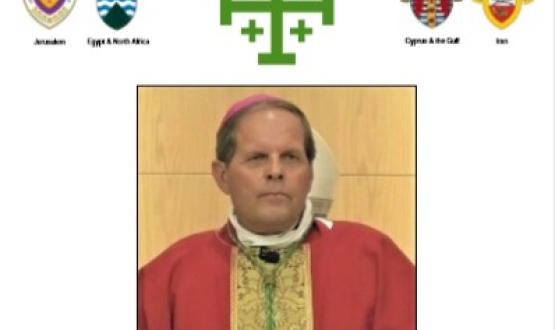Becoming a Province In 2017, the Diocese of Egypt with North Africa and the Horn of Africa made the following resolution: “The members of the Diocesan Synod support the process and studies that aim to transform the Diocese of Egypt with North Africa and the Horn of Africa into a Province within the Anglican Communion.”
This was re-emphasised again during the Diocesan Executive Board 28 February, 2018. The Diocese of Egypt with North Africa and the Horn of Africa currently covers eight countries, and has two Episcopal areas, one in North Africa and the other in the Horn of Africa. The Diocese of Egypt is rapidly growing in an unexpected way, especially in the Horn of Africa. The number of churches in Ethiopia has grown from seven churches in 2000 to 141 in 2017. The number of congregations in North Africa has grown from three congregations in 2000 to nine congregations in 2017, with the possibility of expansion in Mauritania and Chad.
The Church in Egypt has also grown. We have seven new churches, ten new congregations and eleven new institutions. In respect to this growth, Egypt will transition easily into a diocese. The Horn of Africa will be two dioceses. One diocese will be at the lowlands in Ethiopia and the other will consist of the highlands with Eritrea, Djibouti and Somalia. North Africa is currently made up of three countries, Libya, Tunisia and Algeria, with the potential to become five countries with the expansion into Mauritania and Chad, so it will become a diocese of its own.

The future Diocese of Egypt will consist of the country of Egypt only. The population of Egypt is 84,475,000 with Arabic being the language. 86.67% of the population is Muslim and 12.83% of the population is Christian. The Diocese of Egypt will consist of 26 congregations, various ministerial institutions and a theological school which has three branches.
The Diocese of Gambella will consist of the lowlands of Ethiopia. The Gambella region of Ethiopia has a population of 307,000. It is comprised of many ethnic groups, with the six largest being Nuer, Anuak, Amhara, Oromo, Mezhenger and Kafficho. There are various languages spoken according to the various ethnic groups. 5% of the population is Muslim, 4% practice traditional religions and the remaining 91% are Christian. The Diocese of Gambella will be made up of over 100 churches which are already open in this region.
The Diocese of the Horn of Africa will be comprised of the highlands of Ethiopia, Eritrea, Djibouti and Somaliland. Eritrea has a population of 5,223,994 with languages of Tigrinya, Tigre, Arabic and English. Muslims make up 50.26% of the population and Christians make up 47.31% of the population. We have one congregation and one church. Djibouti has a population of 879,053 with languages of French and Arabic. 97.03% of the population is Muslim and 1.75% of the population is Christian. We do not have a church there, but we have a few families who currently meet at home or at the Catholic Cathedral. Somaliland has a population of 3,500,000. The official language is Somali but English and Arabic are widely spoken. The official religion in Somaliland is Islam. Individuals are free to practice their own religion but it is illegal to propagate religions outside Islam.
The Diocese of North Africa will consist of Libya, Tunisia and Algeria with the opportunity to expand to Chad and Mauritania. Libya has a population of 6,545,619 who speak Arabic. Muslims compose 97.02% of the population, and Christians compose 2.64%. We have one church and three congregations. Tunisia has a population of 10,373,957. Arabic is the official language but French and English are widely utilized. 99.37% of the population is Muslim and 0.22% of the population is Christian. We have two churches and three congregations in Tunisia. Algeria has a population of 35,422,589 who speak Arabic and Berber. The population is 97.29% Muslim and 0.28% Christian. We have one church with three congregations, as well as four house churches. We hope to expand into Chad and Mauritania in the near future. Chad has a population of 11,506,130 who speak French and Arabic. 52.84% of the population is Muslim and 38.46% of the population is Christian. Mauritania has a population of 3,365,675 who speak Arabic, French and the Hassaniya Dialect. 99.75% of the population is Muslim and 0.25% of the population is Christian.
The current Diocese of Egypt is already recognized as a separate entity by the Council of Anglican Provinces in Africa (CAPA), and pays a subscription as a member of CAPA. In other words, the Diocese of Egypt has been a member of both the Province of Jerusalem and the Middle East and CAPA, which is a bit odd. It is worth mentioning that in May of 2018, the Primates of CAPA unanimously welcomed the idea that Egypt would become a province within CAPA, rather than just a diocese.
The historical legacy of the Church in the region of North Africa and the Horn of Africa is significant. It is known that the Churches of Alexandria, Carthage, Hippo and Abyssinia have shaped the Christian mind of the whole world during the first millennium. The Church fathers of this region have contributed widely to the theology and the ecclesiology of the Anglican Communion. Some people say that if you are African, you are Anglican twice. That is because the Anglican reformers returned to the early fathers of Alexandria and Carthage to reform the Anglican Church when it became independent of Rome.
The new province will be named the Province of Alexandria because of the historical significance of Alexandria. The new Province of Alexandria will be keen to maintain a good relationship with the Province of Jerusalem and the Middle East.
Diocese of Egypt

